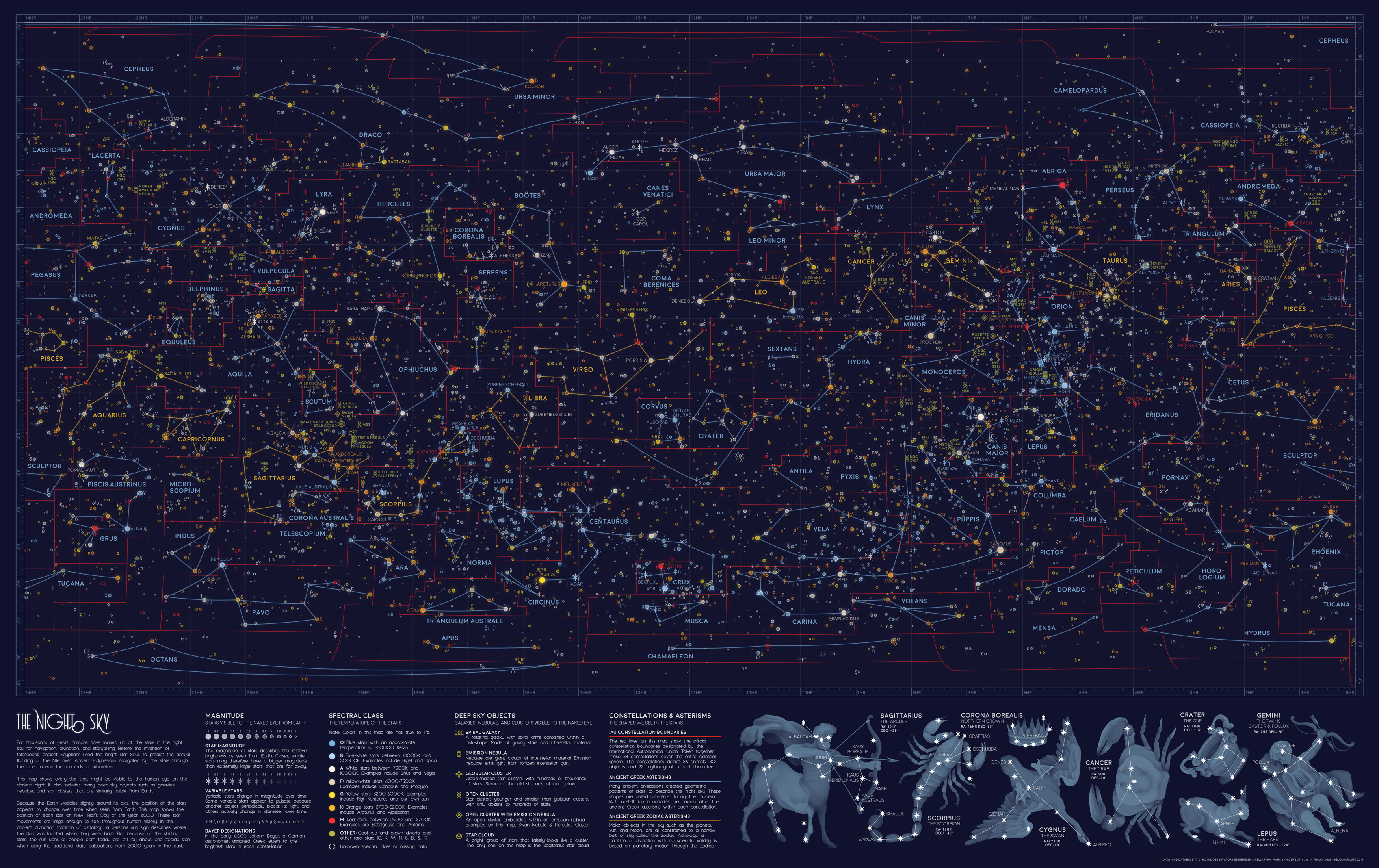 View the full-size version of this infographic
View the full-size version of this infographicThe stars have fascinated humanity since the beginning of civilization, from using them to track the different seasons, to relying on them to navigate thousands of miles on the open ocean.
Today, travelers trek to the ends of the Earth to catch a glimpse of the Milky Way, untouched by light pollution.
However, if you’re in the city and the heavens align on a clear night, you might still be able to spot somewhere between 2,500 to 5,000 stars scattered across your field of vision.
This stunning star map was created by Eleanor Lutz, under the Reddit pseudonym /hellofromthemoon, and is a throwback to all the stars and celestial bodies that could be seen by the naked eye on Near Year’s Day in 2000.
Star Light, Star Bright
Stars have served as a basis for navigation for thousands of years.
Polaris, also dubbed the North Star in the Ursa Minor constellation, is arguably one of the most influential, even though it sits 434 light years away.
Because of its relative location to the Earth’s axis, Polaris is reliably found in the same spot throughout the year—on this star map, it can be spotted in the top right corner.
The Polynesian people famously followed the path of the North Star, along with wave currents, in all their way-finding journeys.
Interestingly, Polaris’ dependability is why it is commonly mistaken as the brightest star, but Sirius actually takes that crown—find it below the Gemini constellation, at the 7HR latitude and -20° longitude coordinates on the visualization.
Located in the Canis Majoris constellation, Sirius burns bluish-white, and is one of the hottest objects in the universe with a surface temperature of 17,400°F (9,667°C). Sirius is nearly 40 times brighter than our Sun.
The Egyptians associated Sirius with the goddess Isis, and used its location to predict the annual flooding of the Nile.
This also isn’t the only way humans have used visible stars to “predict” the future, as evidenced by the ancient practice of astrology.
Seeking Answers in the Stars
In the star map above, the orange lines denote the twelve signs of the Zodiac, each found roughly along the same band from 10° to -30° longitude. These Zodiac alignments, along with planetary movements, form the basis of astrology, which has been practiced across cultures to predict significant events. While the scientific method has widely demonstrated that astrology doesn’t hold much validity, many people still believe in it today.
The red lines on the visualization signify the constellations officially recognized by the International Astronomical Union (IAU) in 1922.
Its ancient Greek origins are recorded on the same map as the blue lines, from which the modern constellation boundaries are based.
Here’s a deeper dive into all 88 IAU constellations:
(Source: International Astronomical Union)
Constellation English Name Category Brightest star
- Andromeda Chained Maiden/ Princess Creature/ Character Alpheratz
- Antlia Air Pump Object α Antliae
- Apus Bird of Paradise Animal α Apodis
- Aquarius Water Bearer Creature/ Character Sadalsuud
- Aquila Eagle Animal Altair
- Ara Altar Object β Arae
- Aries Ram Animal Hamal
- Auriga Charioteer Creature/ Character Capella
- Boötes Herdsman Creature/ Character Arcturus
- Caelum Engraving Tool Object α Caeli
- Camelopardalis Giraffe Animal β Camelopardalis
- Cancer Crab Animal Tarf
- Canes Venatici Hunting Dogs Animal Cor Caroli
- Canis Major Great Dog Animal Sirius
- Canis Minor Lesser Dog Animal Procyon
- Capricornus Sea Goat Creature/ Character Deneb Algedi
- Carina Keel Object Canopus
- Cassiopeia Seated Queen Creature/ Character Schedar
- Centaurus Centaur Creature/ Character Rigil Kentaurus
- Cepheus King Creature/ Character Alderamin
- Cetus Sea Monster Creature/ Character Diphda
- Chamaeleon Chameleon Animal α Chamaeleontis
- Circinus Compass Object α Circini
- Columba Dove Animal Phact
- Coma Berenices Bernice's Hair Creature/ Character β Comae Berenices
- Corona Australis Southern Crown Object Meridiana
- Corona Borealis Northern Crown Object Alphecca
- Corvus Crow Animal Gienah
- Crater Cup Object δ Crateris
- Crux Southern Cross Object Acrux
- Cygnus Swan Animal Deneb
- Delphinus Dolphin Animal Rotanev
- Dorado Swordfish Animal α Doradus
- Draco Dragon Creature/ Character Eltanin
- Equuleus Little Horse Animal Kitalpha
- Eridanus River Object Achernar
- Fornax Furnace Object Dalim
- Gemini Twins Creature/ Character Pollux
- Grus Crane Animal Alnair
- Hercules Hercules Creature/ Character Kornephoros
- Horologium Pendulum Clock Object α Horologii
- Hydra Female Water Snake Creature/ Character Alphard
- Hydrus Male Water Snake Creature/ Character β Hydri
- Indus Indian Creature/ Character α Indi
- Lacerta Lizard Animal α Lacertae
- Leo Lion Animal Praecipua
- Leo Minor Lesser Lion Animal Regulus
- Lepus Hare Animal Arneb
- Libra Scales Object Zubeneschamali
- Lupus Wolf Animal α Lupi
- Lynx Lynx Animal α Lyncis
- Lyra Lyre Object Vega
- Mensa Table Mountain Object α Mensae
- Microscopium Microscope Object γ Microscopii
- Monoceros Unicorn Creature/ Character β Monocerotis
- Musca Fly Animal α Muscae
- Norma Carpenter's Square Object γ2 Normae
- Octans Octant Object ν Octantis
- Ophiuchus Serpent Bearer Creature/ Character Rasalhague
- Orion Hunter Creature/ Character Rigel
- Pavo Peacock Animal Peacock
- Pegasus Winged Horse Creature/ Character Enif
- Perseus Hero Creature/ Character Mirfak
- Phoenix Phoenix Creature/ Character Ankaa
- Pictor Painter's Easel Object α Pictoris
- Pisces Fishes Animal Alpherg
- Piscis Austrinus Southern Fish Creature/ Character Fomalhaut
- Puppis Stern Object Naos
- Pyxis Mariner's Compass Object α Pyxidis
- Reticulum Reticle (Eyepiece) Object α Reticuli
- Sagitta Arrow Object γ Sagittae
- Sagittarius Archer Creature/ Character Kaus Australis
- Scorpius Scorpion Animal Antares
- Sculptor Sculptor Creature/ Character α Sculptoris
- Scutum Shield Object α Scuti
- Serpens Serpent Animal Unukalhai
- Sextans Sextant Object α Sextantis
- Taurus Bull Animal Aldebaran
- Telescopium Telescope Object α Telescopii
- Triangulum Triangle Object Atria
- Triangulum Australe Southern Triangle Object β Trianguli
- Tucana Toucan Animal α Tucanae
- Ursa Major Great Bear Animal Alioth
- Ursa Minor Little Bear Animal Polaris
- Vela Sails Object γ2 Velorum
- Virgo Maiden Creature/ Character Spica
- Volans Flying Fish Animal β Volantis
- Vulpecula Fox Animal Anser
Grand Map of the Night Sky
source : Halcyon Maps
Into the Depths of Deep Space
The quirk of naming stars after flora and fauna doesn’t end there.
Our night sky also reveals visible galaxies, nebulae, and clusters far, far away—but they’re named after familiar birds, natural objects, and mythical creatures.
See if you can find some of these interesting names:
- Open Cluster: Wild Duck Cluster
- Open Cluster: Eagle Nebula
- Open Cluster: Beehive Cluster
- Open Cluster: Butterfly Cluster
- Emission Nebula: North American
- Emission Nebula: Trifid Nebula
- Emission Nebula: Lagoon Nebula
- Emission Nebula: Orion Nebula
- Open Cluster with Emission Nebula: Swan Nebula
- Open Cluster with Emission Nebula: Christmas Tree Cluster
- Open Cluster with Emission Nebula: Rosette Nebula
- Globular Cluster: Hercules Cluster
Another one can be seen next to Cassiopeia, just below Polaris between 1HR-3HR latitude, at 60° longitude.
The only two visible spiral galaxies, Andromeda and Pinwheel, are located close between 0-2HR latitude and 30°-40° longitude.
The Relentless Passage of Time
We now know that the night sky isn’t as static as people used to believe.
Although it’s Earth’s major pole star today, Polaris was in fact off-kilter by roughly 8° a few thousand years ago.
Our ancestors saw the twin northern pole stars, Kochab and Pherkad, where Polaris is now.
This difference is due to the Earth’s natural axial tilt.
Eight degrees may not seem like much, but because of this angle, the constellations we gaze at today are the same, yet completely different from the ones our ancestors looked up at.
Links :
- GeoGarage blog : Map to the stars

No comments:
Post a Comment